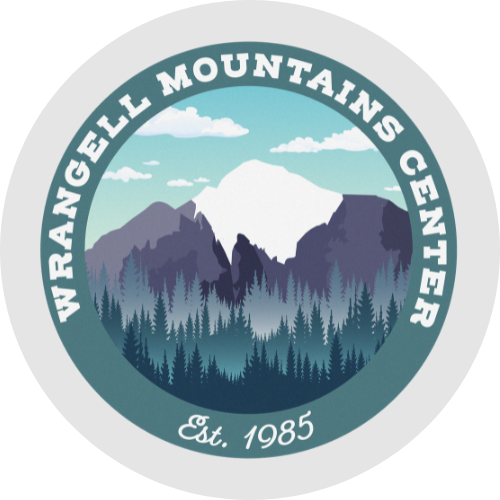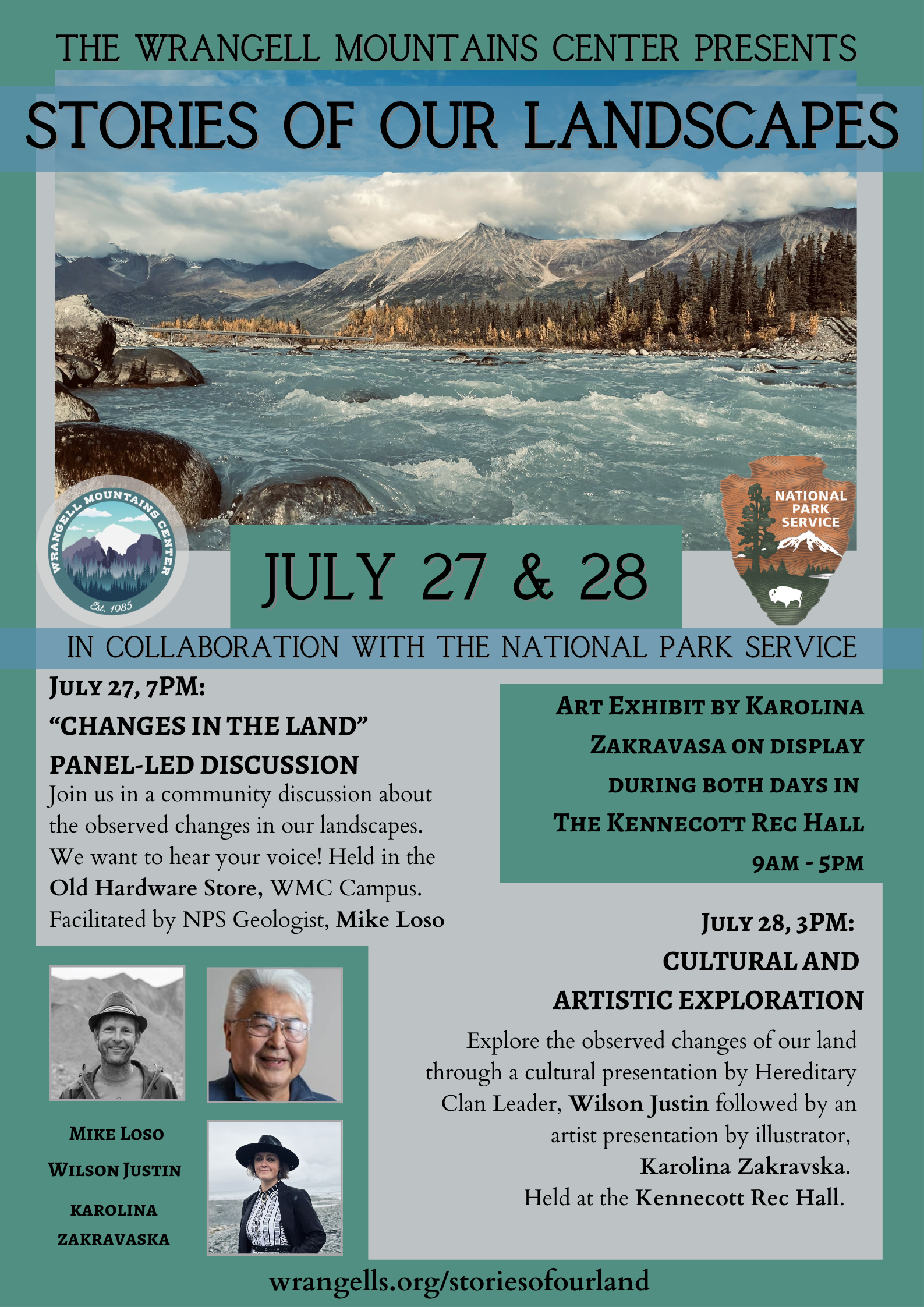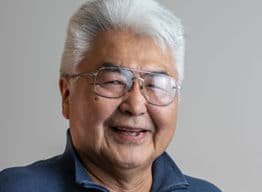Stories of Our Landscapes
July 27 & 28
During this two day weekend event, participants will engage with the inspirational, cultural, and foundational relationships to place in the Wrangell Mountains through community, art and culture.
“Stories of Our Landscapes” Art Exhibit will be open both days in the Kennecott Recreation Hall from 9am-5pm
Hosted by the Wrangell Mountains Center in collaboration with the National Park Service.
Day One:
Changes in the Land, Panel-led Community Discussion
July 27 @ 7pm - Old Hardware Store
Facilitated by NPS Geologist, Mike Loso
Join us in a panel-led community discussion about the observed changes in our landscapes. By opening up a space to allow McCarthy-Kennicott locals to tell their stories of the changes in our landscapes, we can create bridges across communities and experience a deeper connection grounded in our relationship to place. We seek to hold inclusive discussions, and honor the diverse voices of area residents who have observed our landscapes for generations. All attendee voices and landscape observations are welcome during the discussion. We want to hear from you!
We welcome panelists:
Jeannie Miller, Sally Gibert, Paul Claus, Chris Larsen, and Zach Barrett
Day Two:
Cultural and Artistic Exploration with Special Guest and Hereditary Clan Leader, Wilson Justin and featuring artist Karolina Zakravaska.
July 28 @ 3pm - Kennecott Recreation Hall
We welcome guest speaker, Wilson Justin, to present cultural perspectives of the changes in our landscapes, specifically the effects of climate change and mining in our area and surrounding areas through the lens of Indigenous populations. We hear about the personal impact these changes have on Alaska Native communities and culture and a proposed way forward.
We then welcome artist Karolina Zakravaska to present her work in the “Stories of Our Landscape” Art Exhibit (featured all weekend in the Kennecott Rec Hall). Karolina’s work represents her observed changes in the land and her personal relationship to the Kennicott Valley and surrounding areas.
About Our Guests
Wilson Justin
Hereditary Leader and Keeper of Sacred Stories
Wilson Justin was born in midcentury at Nabesna Alaska, a village later abandoned to comply with the educational requests of the Bureau of Indian Affairs. The family endured a decade of hardships in Chistochina and Mentasta Village but returned to the homelands for the summer months. As an adventurous youngster, Wilson Justin was prone to chase shadows and was on the road by the age of fourteen. Threatened with receivership at the Children’s Home in Fairbanks, he returned to Mentasta Village in 1965 and soon after followed the rest of the family to Anchorage, graduating from West Anchorage High School in 1968.
Right out of high school, Wilson volunteered for the Draft with the U.S. Army. The backlist of draftees kept Wilson from a physical until the Fall of 1969, where, to his surprise, he failed the physical due to tinnitus. Not long after, he asked for a review of the classification, which was 1 Y. In 1973, the Army sent him a letter of response changing the 1 Y classification to 4 F. While waiting for the Army response, Wilson spent time in Alaska's legendary Big Game Business. Once the Army was no longer a viable option, Wilson began thinking of what kind of a career could be fashioned for an Athabascan with just a high school diploma. There were no instructions in the sudden transition from a Traditional Society to a one descended from an English speaking world. Wilson had a natural curiosity of the world and soon was able to join the ANCSA Corporation for his region as a Land Planner Trainee in 1977.
For many years thereafter Wilson would alternate between the corporate world and the Outdoor Big Game Guiding Business. At the same time Mentors from the Traditional Athabascan world would journey to the Nabesna country to speak of stories and medicine men of the Headwaters People. Trips to other parts of the region invariably ended up in Stories of the olden times and narrative of wars that occupied the Ahtna Nation prior to Contact. This duel trail of western corporate culture running parallel to the Traditional Teaching became a part of Wilson’s background until the late 1990's when the last of the Clan Storytellers and Story keepers passed on. It was in this decade that Climate Change began to show its face in his recounting of the times his family lived through Post WW2.
In 1993, after leaving Ahtna, Wilson began another quest in a new field. He helped start a Health Organization under Title V, an Act of Congress to allow Tribes to contract Health services directly with the Indian Health Service. Named to the position of Health Director, Wilson represented Mt. Sanford Tribal Consortium for 17 years in yearly negotiations with the Federal Government on the meaning, costs. impact, and definition of Health Service in Rural Alaska.
Wilson has advised federal agencies such as the United States Environmental Protection Agency (USEPA) on issues around environmental program capacity building. In the early 1990s USEPA began writing the Indian Environmental General Assistance Program statute (IGAP Act of 1992). Wilson played a critical role in the initial structuring of this program and its evolution over the years as a group from just a handful of grants to tribal governments to what it is today with over $27 million in region 10 (Alaska) and over 125 tribes state wide choosing to partner on this program. He has directed IGAP programs including Mount Sanford’s environmental program overseeing the development of a successful regional recycling program. Wilson has professionally attended conferences for decades. He has led numerous discussions on climate change as an acclaimed speaker during interdisciplinary conferences such as the Alaska Forum on the Environment. The publication titled Alaska Forum on the Environment: Climate change: Our voices, Sharing our Ways Forward, became a component of the US Department of the Interior, US Geological Survey, United States National Climate Assessment, Alaska Technical Regional Report (Circular 1379).
Karolina Zakravska
Illustrator & Designer focused on educational materials with interest in nature, fauna and flora, history, and traditions in Alaska.
Artist Statement:
My passion is in the natural world and exploration. Through my illustrations, cyanotype, and paintings I aim to educate through art and make sometimes overlooked information accessible in fun and meaningful ways. I strive to evoke a sense of wonder and curiosity in viewers of all ages. My work serves as a visual gateway to understanding and appreciating our environment from dierent perspectives, fostering a deeper connection to the land. Through each piece, I aspire to inspire a greater respect for nature, culture, and promote environmental stewardship.
Why are our Alaskan landscapes important to you? How have you been impacted by the changes you have observed?
The Alaskan land is important to me because it is my home, a place close to my heart, and a place I am grateful for every day. I strive to learn about our land from different perspectives and hope to do my part to preserve it for future. The first place I lived in Alaska after moving from the Czech Republic was McCarthy and it is where my learning about subsistence lifestyle began. Living above Kennecott and off-grid changed my desire and understanding of what lifestyle I am good at and what lifestyle truly fulfills me and makes me content. Over the years I have been able to go hunting for sheep or caribou, fish in places I never imagined I would, and gather and garden. Along my explorations on foot or by dog sled, I have seen how the landscape changes during the year, but also over longer periods of time. How creeks shift and glaciers melt at a faster rate than anywhere else. In almost a decade I have lived in Alaska, I’ve seen places like McCarthy grow and become more developed and others get smaller. Working in education and with native population in the Copper Basin area from Valdez to Mentasta, I have seen cultural traditions be celebrated but also sometimes get less attention with younger generations. As someone who values history, culture, and nature around us, I try and help preserve it. Through my work with the Copper Basin 300 Sled Dog Race, I do my best to help educate the public about the traditions of dog mushing. Through my NALES Project I strive to educate about landmarks around Alaska and beyond to help preserve cultural knowledge while promoting different landmarks and help make information accessible. My first illustrated series is the Wrangell St. Elias as it is the area that will always be my home, that I know well, and that is close to me. Through nature journaling or cyanotype with friends and students, I teach the importance of paying attention to our surroundings. My hope is that through my work I help people understand our land a bit better, and maybe even strike curiosity and desire to learn more and preserve it for future generations. For this opportunity, I would showcase my illustrations and infographics, cyanotype, prints, my personal studies of the subject, and more in a series focused on the Wrangell St. Elias NP and how I’ve observed its changes while focusing on including place names and geological information about each landmark in the series. Various materials including prints, stickers, and embroidered patches would be available for purchase on my website or in person. Through the sales I am able to expand this project sustainably and continuously.






